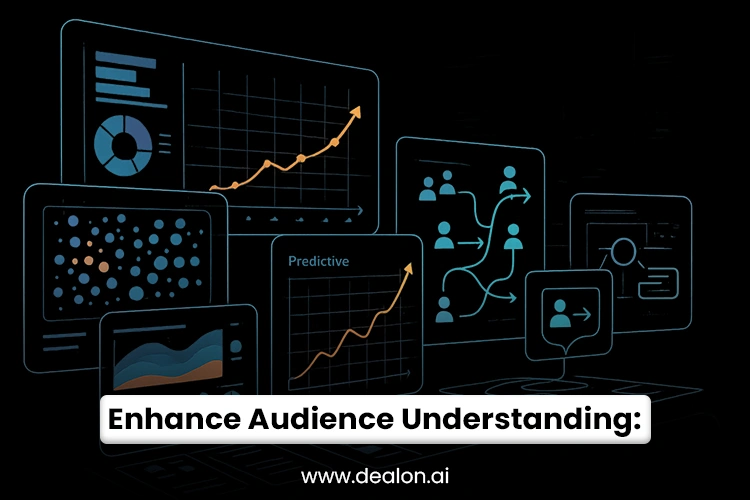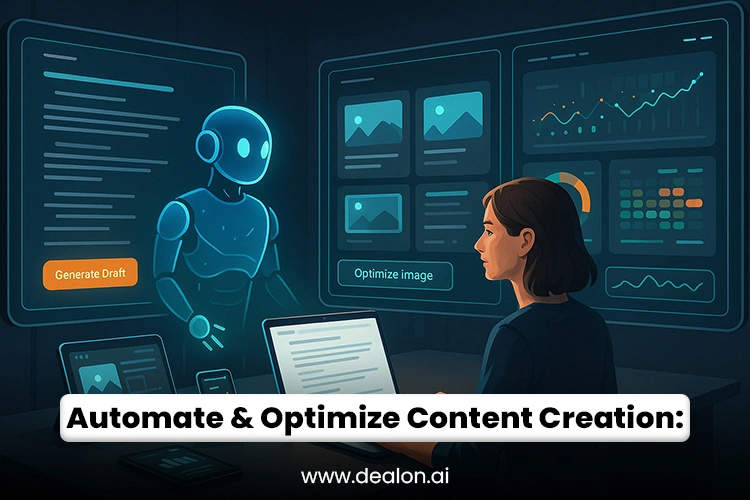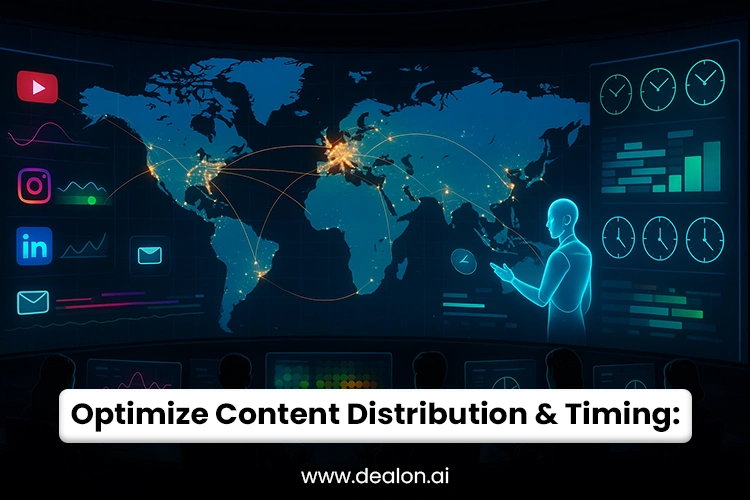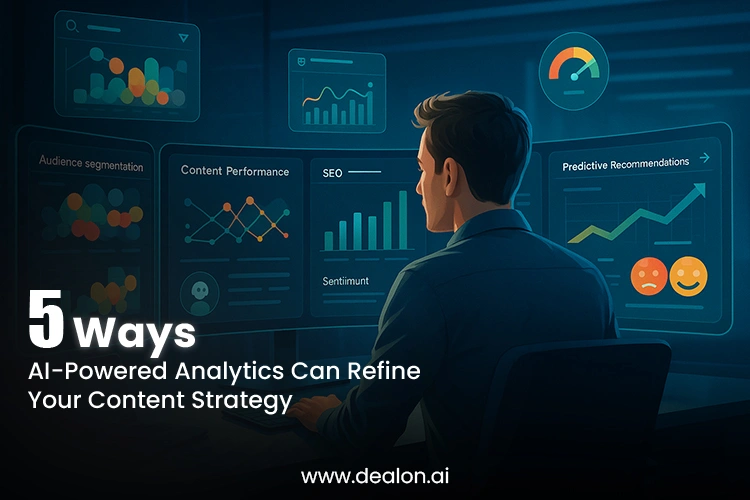In the hyper-competitive digital ecosystem, content reigns supreme. However, crafting content that captures attention and drives meaningful outcomes demands far more than creative flair alone. To truly excel, businesses must employ the power of data—specifically, AI-powered analytics—to precisely refine their content strategies. Gone are the days of guesswork; today, content success hinges on data-driven insights that provide a granular understanding of audience behavior, preferences, and trends. AI analytics allows processing of vast amounts of data at unparalleled speed, transforming raw information into actionable strategies that can drive engagement, conversions, and loyalty.
By leveraging AI’s sophisticated capabilities, brands can anticipate trends, optimize content distribution, and personalize messaging to resonate deeply with their target audience. Moreover, AI enables real-time performance tracking, allowing brands to make swift, informed adjustments for continuous improvement. As the digital space becomes more saturated, relying on AI to fine-tune your content strategy isn’t just advantageous—it’s essential. In this blog, we will delve into five groundbreaking ways AI-powered analytics can redefine your content strategy, guaranteeing your brand remains at the forefront of the digital narrative and maximizes its impact in an ever-evolving landscape.
Also Read: AI and Hyper-Personalization: Crafting Unique Customer Experiences in Real-Time
1. Enhance Audience Understanding with Predictive Analytics

Comprehending your audience is the cornerstone of an effective content strategy in the ever-evolving digital space. While traditional audience research methods provide valuable insights, AI-powered predictive analytics elevate this process by offering deeper, data-driven foresight. By harnessing vast amounts of historical data, predictive analytics doesn’t just help businesses understand current audience behavior—it equips them with the tools to anticipate future trends, needs, and preferences with remarkable accuracy.
At the center of predictive analytics is the capacity to analyze patterns in user behavior across multiple touchpoints. This data is processed through MLA, identifying subtle trends and correlations and helping brands anticipate what topics, content formats, and emotional triggers resonate most with their target audience. AI can go a step further by recognizing shifts in sentiment, highlighting emerging trends before they become mainstream, and forecasting how they will evolve.
Predictive analytics enables brands to move beyond merely reacting to current audience behaviors. By identifying emerging interests or latent needs, AI allows you to proactively design content that speaks to what your audience will want shortly. For example, AI can analyze search patterns, social media discourse, and news cycles to predict the rise of specific topics or ideas. By aligning your content strategy with these predicted trends, you position your brand as a thought leader and relevant resource in an increasingly competitive space.
Gone are the days of creating generic content for a broad audience. With predictive analytics, you can deliver highly personalized experiences by forecasting what specific segments of your audience will find most compelling. AI-powered insights enable you to divide your audience more accurately, customizing content based on demographics, behavior trends, and past interactions. This ensures your content speaks directly to individual needs, significantly improving engagement, loyalty, and conversion rates.
Predictive analytics provides invaluable guidance on which content formats—blog posts, videos, podcasts, or infographics—perform best for specific audience segments. Furthermore, it can predict the optimal channels for distribution, be it social media platforms, email marketing, or paid advertising. By understanding the nuances of content consumption behavior, AI helps streamline your content distribution strategy, ensuring maximum reach and impact.
Predictive analytics helps mitigate the risk of content saturation by offering data-driven insights on content topics that are underrepresented or not yet fully explored. This permits you to develop content that fills gaps in the market and meets an audience demand that hasn’t been fully addressed.
By leveraging the power of predictive analytics, your content strategy becomes reactive and anticipatory. This ensures your content remains relevant, innovative, and deeply connected to your audience’s ever-evolving needs. Predictive analytics empowers your brand to forge deeper connections, stay ahead of trends, and deliver timely and meaningful content.
2. Automate and Optimize Content Creation

AI tools can streamline this methodology by analyzing search trends, social media discussions, and keyword performance across search engines. This data enables AI to suggest highly relevant and trending topics, providing a steady stream of content ideas primed for success. By automating this research phase, AI saves time and saves time and ensures that your content is consistently aligned with audience interests and SEO opportunities.
Once a topic is chosen, AI tools and analytics can further accelerate the content creation by generating initial drafts or outlines based on predefined guidelines. These initial drafts provide a strong starting point that content creators can further tailor and enhance to suit their specific needs. AI-generated content is often highly structured, following best practices for readability, engagement, and SEO. This initial automation allows content teams to focus on refining the tone, voice, and narrative, thus elevating the quality of the final product while saving valuable time.
In addition to content creation, AI tools optimize content for search engines. From analyzing keyword density to suggesting internal and external links, AI can ensure your content is optimized to rank highly on search engines. Moreover, AI tools can recommend meta descriptions, alt texts, and keyword variations to enhance the probability of your content occurring in search results. By automating these crucial SEO tasks, AI ensures your content is well-crafted and strategically positioned to reach your audience effectively.
AI tools and analytics can help enforce consistency by analyzing previous content and generating new material that adheres to the same style guide. Whether ensuring the appropriate use of brand language or maintaining sentence structure, AI systems ensure that all pieces align with your content strategy, creating a cohesive and professional brand image.
Rather than spending excessive time on research, drafting, and optimization, your team can focus more on refining messaging, trying out new formats, and interacting directly with your audience. AI doesn’t replace human creativity—it amplifies it, enabling teams to create higher-quality content faster, all while improving SEO performance and content relevance. In a world where agility and innovation are key to staying competitive, AI-powered analytics is essential in refining your content strategy.
3. Improve Content Personalization for Enhanced Engagement
In today’s digital ecosystem, generic content no longer captures the attention or loyalty of consumers. Audiences increasingly expect personalized experiences tailored to their unique needs, preferences, and behaviors. AI-powered analytics offers a sophisticated way to craft hyper-targeted content by analyzing vast data, allowing brands to engage their audience meaningfully and effectively. By leveraging AI’s ability to segment audiences based on behavior, interactions, and preferences, businesses can create customized content that resonates on a deeper level, leading to increased conversion rates.
AI-driven content personalization is grounded in data analytics. By collecting and analyzing behavioral data—such as clicks, time spent on a page, purchase history, and social media interactions—AI tools can segment audiences into particular groups. This segmentation goes beyond simple demographic categories; it identifies the nuances of customer preferences, online behavior, and even emotional triggers that influence decision-making. With these insights, AI enables brands to create content perfectly aligned with each audience segment’s interests, pain points, and motivations.
AI’s ability to analyze and categorize audience data allows brands to create granular audience segments based on detailed behavior patterns. Whether it’s segmenting by age, location, past purchase history, or even how users interact with your website, AI can help identify groups with specific needs and desires. This granular understanding permits you to tailor your content accordingly—delivering personalized recommendations, crafting specific blog topics, or creating dynamic landing pages that adapt to individual preferences.
Personalization goes beyond just customizing the messaging. AI empowers dynamic content delivery, where the content presented to users adapts in real time to their actions. For example, based on the user’s browsing history or past purchases, AI can dynamically adjust website content, offering personalized product recommendations, content suggestions, or even special offers highly relevant to the individual. This real-time adaptability creates a more immersive and engaging experience, as users are presented with content that is always in tune with their current interests and needs.
AI-driven personalization is particularly impactful in email marketing. AI can optimize email content by analyzing customer behavior and interactions with previous campaigns, ensuring it resonates with individual recipients. Whether it’s the subject line, the tone of the copy, or the products featured, AI can dynamically adjust these elements to ensure they align with each recipient’s preferences.
AI doesn’t just react to past behavior; it can also predict future behavior. Using machine learning algorithms, AI can forecast what content an individual is likely to engage with next based on patterns identified in similar users. By predicting these preferences, you can proactively serve content that aligns with their anticipated interests, further enhancing their experience. Whether it’s suggesting future blog articles, videos, or product offerings, predictive personalization ensures that your audience always feels like you understand their needs, making it more probable that they will resume engaging with your brand.
Personalized content fosters deeper engagement, which leads to longer time spent on your site, more interactions with your brand, and higher chances of conversion. By delivering the right content at the right time, AI helps nurture leads through the customer journey, guiding them seamlessly from awareness to consideration and, ultimately, to conversion. Personalized content ensures that the path to purchase is aligned with each user’s unique preferences and behaviors, reducing friction and increasing the likelihood of conversion.
AI-driven content personalization enhances the relevance of your messaging and ensures that each interaction is tailored to your audience’s needs. As engagement increases and audience loyalty strengthens, businesses experience improved metrics—more extended site visits, higher conversion rates, and enhanced customer retention. In essence, AI takes content strategy to the next level, making it more effective, more personal, and more impactful.
4. Optimize Content Distribution and Timing

In digital content, creation is just one part of the equation. For content to truly drive results, it must be delivered to the right audience at the optimal moment. AI analytics have revolutionized content distribution by providing precise insights into when and where content will most likely be effective. By analyzing audience behavior, social media patterns, and historical engagement data, AI can pinpoint the best times to post, identify the most suitable channels for distribution, and suggest the most engaging content formats. This ensures that your content not only reaches your audience but does so at the peak of their engagement.
AI can analyze large datasets to uncover patterns in user behavior, such as the times and days when your audience is most active. By understanding these behaviors, AI can provide specific recommendations on the best times to schedule posts, emails, or content releases. This data-driven approach eliminates the guesswork often accompanying content scheduling, ensuring that your content is distributed when engagement is most likely to peak. Whether social media posts, blog articles, or email newsletters, AI helps ensure your content hits the correct mark at the right moment.
Not all content is suited for every platform. AI can evaluate your audience’s interactions across various channels—social media, email, blogs, or websites—and suggest the most effective channels for distribution. By leveraging AI’s insights, brands can avoid wasting resources on channels that yield minimal results while focusing on those that drive the most engagement. This enables a more streamlined and effective content distribution strategy, guaranteeing that your message reaches the right audience in the right place.
The effectiveness of content isn’t just determined by when and where it’s posted but by the format in which it’s delivered. AI can help identify which formats—articles, videos, infographics, or podcasts—will most likely resonate with your audience on specific platforms. Tailoring content to the appropriate format increases the chances of higher engagement and ensures your content stands out in a crowded digital landscape.
AI’s ability to optimize content distribution and timing empowers brands to refine their content strategy, guaranteeing maximum engagement with their target audience. By utilizing AI’s insights, content is not just created—it’s strategically delivered to achieve its full potential.
5. Track Performance in Real-Time and Make Data-Driven Adjustments
In an ever-evolving digital landscape, static content strategies are no longer effective. Tracking and adjusting content performance in real-time is a crucial advantage that AI-powered analytics brings. Traditional methods of tracking performance often rely on retrospective analysis. Still, AI can continuously monitor and analyze key metrics such as engagement rates, click-through rates, social shares, and conversions as they happen. This real-time insight empowers businesses to make rapid, data-driven adjustments, ensuring their content strategy remains dynamic, relevant, and on target.
AI offers the unprecedented ability to observe performance as content is being consumed. By leveraging real-time analytics, businesses can track metrics like user engagement, bounce rates, and social media interactions as they occur. This continuous data stream enables real-time feedback on content performance, quickly revealing what’s working and what needs improvement in the strategy. AI ensures that every content is continuously optimized for maximum impact, eliminating the lag time inherent in traditional tracking methods.
With the power of real-time data, AI enables agile content strategies that are constantly evolving. If a particular piece of content is underperforming, AI can highlight this immediately, allowing teams to revise headlines, optimize visuals, or tweak messaging to improve performance. Conversely, if a piece of content performs exceptionally well, AI can help amplify its reach or replicate its success in future campaigns. This agile approach keeps content strategies relevant, allowing businesses to pivot quickly in response to audience behavior and market trends.
AI doesn’t just react to current performance—it also helps brands stay ahead of emerging trends. By continuously analyzing data and tracking user interactions, AI can identify shifts in audience preferences and behaviors. This allows brands to capitalize on these trends early, creating content that aligns with evolving interests and increasing the likelihood of viral success. With AI, content strategies aren’t just reactive; they’re proactive, ensuring your brand is always one step ahead of the competition.
Conclusion
AI-powered analytics are revolutionizing how businesses craft and refine their content strategies. From enhancing audience understanding through predictive insights to automating content creation and optimizing distribution, AI empowers brands to stay competitive in the digital environment. By utilizing AI-driven personalization, companies can deliver tailored experiences that resonate deeply with target segments, fostering higher engagement and conversion rates. Furthermore, AI’s ability to track performance in real-time enables businesses to make swift, data-driven adjustments, ensuring that their content strategy remains flexible and aligned with ever-changing audience preferences and market dynamics.
As we’ve explored, AI streamlines content processes and adds a layer of intelligence that allows brands to shape their strategies proactively. Whether predicting future trends, automating tedious tasks, or optimizing distribution for maximum reach, AI analytics enhances every aspect of content development and execution. By leveraging these powerful tools, brands can fine-tune their content strategies, ensure relevance, and connect meaningfully with their audience.
Integrating AI into your content strategy has become necessary for businesses looking to succeed in today’s digital landscape. With AI at the helm, content creation and distribution become more intelligent, efficient, and infinitely more effective.

